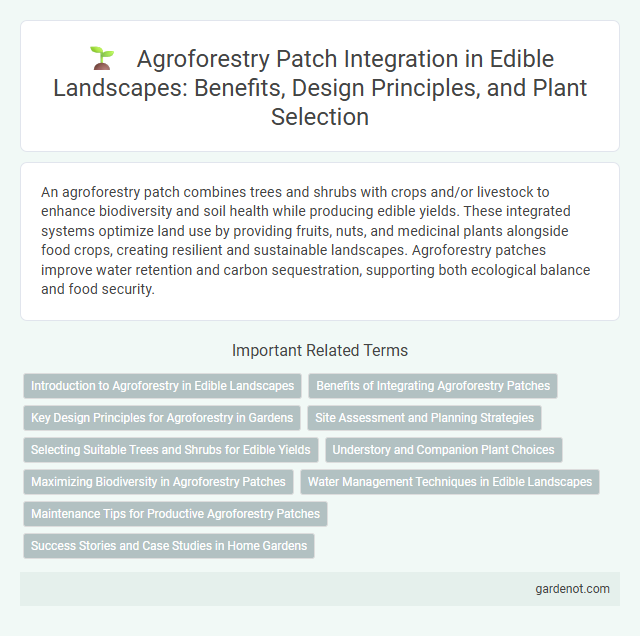An agroforestry patch combines trees and shrubs with crops and/or livestock to enhance biodiversity and soil health while producing edible yields. These integrated systems optimize land use by providing fruits, nuts, and medicinal plants alongside food crops, creating resilient and sustainable landscapes. Agroforestry patches improve water retention and carbon sequestration, supporting both ecological balance and food security.
Introduction to Agroforestry in Edible Landscapes
Agroforestry integrates trees and shrubs into agricultural landscapes to enhance biodiversity, improve soil health, and increase food production. This sustainable practice combines perennial vegetation with crops or livestock, creating multifunctional landscapes that optimize land use. Incorporating agroforestry patches in edible landscapes supports ecosystem services, promotes carbon sequestration, and provides diverse, nutritious food sources year-round.
Benefits of Integrating Agroforestry Patches
Integrating agroforestry patches within edible landscapes enhances biodiversity by providing diverse habitats and supports soil health through improved nutrient cycling and organic matter retention. These patches promote sustainable food production by combining trees, shrubs, and crops, which increase productivity and resilience against pests and climate variability. Moreover, agroforestry systems contribute to carbon sequestration, helping mitigate climate change while offering economic benefits through diversified yields and reduced input costs.
Key Design Principles for Agroforestry in Gardens
Agroforestry patch design in gardens emphasizes integrating diverse plant species to optimize space, enhance soil health, and promote biodiversity. Layers of trees, shrubs, and ground covers are strategically arranged to create microclimates and support beneficial ecological interactions. Key principles include selecting complementary species based on light requirements, rooting patterns, and growth habits to maximize productivity and sustainability.
Site Assessment and Planning Strategies
Agroforestry patch design relies heavily on thorough site assessment, including soil analysis, microclimate evaluation, and water availability to optimize plant selection and placement. Strategic planning incorporates tree-crop interactions, spatial arrangement, and succession planting to enhance biodiversity and maximize yield in the edible landscape. Understanding local ecosystem dynamics and integrating permaculture principles ensures sustainable productivity and resilience within agroforestry systems.
Selecting Suitable Trees and Shrubs for Edible Yields
Choosing the right trees and shrubs for an agroforestry patch is crucial for maximizing edible yields and ensuring ecosystem balance. Species such as chestnut, hazelnut, mulberry, and elderberry provide diverse fruits, nuts, and leaves while supporting soil health and biodiversity. Emphasizing drought-tolerant, native, and nitrogen-fixing plants enhances sustainability and resilience in edible landscape design.
Understory and Companion Plant Choices
Agroforestry patches in edible landscapes enhance biodiversity by integrating understory vegetation that supports soil health and pest management. Selecting companion plants such as nitrogen-fixing legumes, shade-tolerant herbs, and nutrient-accumulating species optimizes growth conditions and maximizes yield in the understory layer. These strategic plant choices foster symbiotic relationships, improve microclimates, and contribute to sustainable ecosystem functioning.
Maximizing Biodiversity in Agroforestry Patches
Agroforestry patches enhance biodiversity by integrating diverse plant species such as native trees, shrubs, and nitrogen-fixing plants, creating a multi-layered habitat for wildlife. This approach promotes soil health, natural pest control, and pollinator support, maximizing ecosystem resilience. Strategic spatial arrangement within these patches fosters connectivity, allowing greater species movement and genetic exchange essential for sustaining biodiversity.
Water Management Techniques in Edible Landscapes
Agroforestry patches in edible landscapes employ advanced water management techniques such as contour planting, swales, and mulching to optimize soil moisture retention and reduce erosion. Deep-rooted trees and shrubs enhance groundwater recharge while creating microclimates that minimize evaporation and promote sustainable crop growth. These integrated water conservation strategies increase resilience to drought and improve overall ecosystem productivity in agroforestry systems.
Maintenance Tips for Productive Agroforestry Patches
Pruning fruit trees regularly in agroforestry patches enhances sunlight penetration and air circulation, boosting fruit quality and yield. Applying organic mulch around tree bases conserves soil moisture, suppresses weeds, and improves soil fertility, supporting healthy plant growth. Monitoring pest and disease activity allows for timely intervention, preserving the productivity and sustainability of the agroforestry system.
Success Stories and Case Studies in Home Gardens
Agroforestry patches in home gardens demonstrate significant improvements in biodiversity and food security, with studies from Southeast Asia showing yield increases of up to 40%. Success stories highlight the integration of fruit trees, medicinal plants, and nitrogen-fixing species that enhance soil fertility and provide year-round harvests. Case studies reveal that these agroforestry systems promote sustainable land use while supporting local livelihoods through diversified produce.
Agroforestry patch Infographic

 gardenot.com
gardenot.com